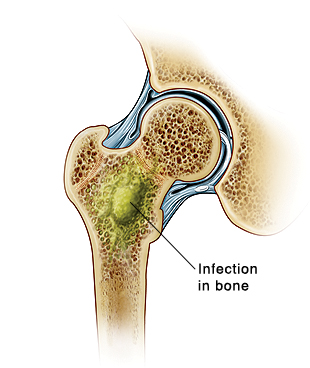 Osteomyelitis is the inflammation of the bones. The infections of bones spreading from neighboring tissues or traveling in the bloodstream. Alternatively, if an injury directly exposes the bone to microorganisms, osteomyelitis can originate in the bone itself.
Osteomyelitis is the inflammation of the bones. The infections of bones spreading from neighboring tissues or traveling in the bloodstream. Alternatively, if an injury directly exposes the bone to microorganisms, osteomyelitis can originate in the bone itself.
In adults, osteomyelitis most frequently affects the vertebrae, whereas in children, the condition is more common in the long bones of the arms and legs. Diabetics who have foot ulcers are susceptible to osteomyelitis in the feet. Common symptoms of osteomyelitis include pain, swelling, warmth and redness in the area of infection, also fevers and chills. Although osteomyelitis was previously considered to be incurable, nowadays there are a variety of treatment methods available.
Osteomyelitis Treatment
The primary aims of osteomyelitis treatment are to stop the infection and to prevent the development of chronic infection, which can result in permanent deformity, possible fractures and other chronic issues. Therefore, it is essential to treat the osteomyelitis as quickly as possible. Osteomyelitis patients are usually hospitalized and treated with a combination of antibiotics and surgery.
1. Medications
The type of infection causing the osteomyelitis will usually be diagnosed using a bone biopsy. Once the cause of the infection is identified, your doctor will select the correct osteomyelitis antibiotics, which are given to you through intravenous injection via an arm vein for 4-6 weeks or longer. You usually receive these injections as an outpatient, so you can return home the same day. During the treatment, you may experience side-effects, such as nausea, diarrhea and vomiting.
An additional course of oral antibiotics could be required once your symptoms improve. Effective oral antibiotics for the treatment of osteomyelitis include rifampin, clindamycin, trimethoprim-sulfamethoxazole, and fluoroquinolones. These are often administered in combination as dual therapy. In certain cases, the bacteria causing the osteomyelitis have developed resistance to some of the antibiotics; in this situation, less frequently used antibiotics may be needed.
2. Surgery
One or more of the following surgical operations may be performed to treat the osteomyelitis, depending on the extent of the infection:
- Drainage. Any excess pus or fluid that has built up because of the infection is drained through opening up the area surrounding the infected bone.
- Remove affected bone and tissue. To make sure that all infected areas are taken out, the surgeon will cut away as much of the affected bone as possible along with a small margin of healthy bone. Sometimes surrounding tissue that may be infected is also removed. This procedure is known as debridement.
- Restore blood flow. Any empty space left from the debridement may be replaced by another bone or other type of tissue, for example muscle or skin, from a different part of the body. The graft allows your body to repair the missing bone tissue and to develop new blood vessels. Short-term "fillers" may be grafted into the area before bone or tissue graft can take place.
- Remove foreign objects. Any foreign objects, such as plates or screws from prior operations, may need to be taken out.
- Splinting or cast immobilization. Immobilizing the affected bone and surrounding joints may be required to prevent any further injury, and to help the area heal correctly and as soon as possible. Splinting and cast immobilization are often performed in children with osteomyelitis, but to prevent atrophy and rigidity, motion of joints after initial control is required.
- Amputation. In serious and rare cases of osteomyelitis resistant to treatment, amputation of the affected limb may be necessary in order to stop the infection spreading any further.
3. Hyperbaric Oxygen Therapy
If the osteomyelitis does not respond to conventional treatment, hyperbaric oxygen therapy, a non-surgical osteomyelitis treatment, may be considered. During this procedure, the patient is placed in a specially designed chamber, similar to decompression chambers employed by divers. Oxygen, at a markedly higher pressure than usually found in the atmosphere, is then fed into the chamber. This procedure is thought to promote healing and halt the spread of infection, although the evidence supporting hyperbaric oxygen therapy for osteomyelitis treatment is limited. It seems to be most effective in treating osteomyelitis originating from diabetic foot ulcers, although this is currently only recommended for use in clinical trials.
Prognosis of Osteomyelitis
The prognosis for patients with osteomyelitis depends greatly on the patient’s general health and their risk factors. If the patient receives prompt diagnosis and treatment, a complete recovery can be achieved, although they will have to be closely monitored over the next few months in case a relapse occurs. The best results are seen in patients who receive treatment within 3-5 days after the initial infection.
Prevention of Osteomyelitis
The best way to prevent osteomyelitis is to keep all injury sites clean. Wash all cuts, particularly deep cuts, thoroughly, rinsing any open wounds under running water for at least 5 minutes before wrapping the injury in sterile bandages.
If you do develop osteomyelitis, get treatment as soon as possible. The earlier osteomyelitis is addressed, the better the chance of recovery, and the lower the likelihood of it developing into a chronic condition.
In cases of chronic osteomyelitis, consult your doctor about how to best manage the condition, ensuring that he or she has your complete medical history. For diabetics, it is important to look after your feet, and to contact a medical professional if you see any sign of infection.
